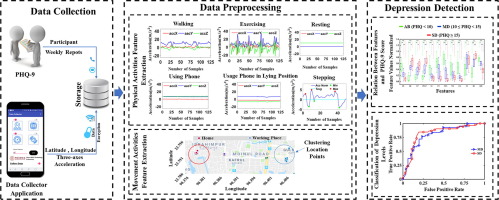当前位置:
X-MOL 学术
›
J. Biomed. Inform.
›
论文详情
Our official English website, www.x-mol.net, welcomes your
feedback! (Note: you will need to create a separate account there.)
Unobtrusive monitoring of behavior and movement patterns to detect clinical depression severity level via smartphone.
Journal of Biomedical informatics ( IF 4.0 ) Pub Date : 2020-01-11 , DOI: 10.1016/j.jbi.2019.103371 Mohammed T Masud 1 , Mohammed A Mamun 2 , K Thapa 3 , D H Lee 3 , Mark D Griffiths 4 , S-H Yang 3
Journal of Biomedical informatics ( IF 4.0 ) Pub Date : 2020-01-11 , DOI: 10.1016/j.jbi.2019.103371 Mohammed T Masud 1 , Mohammed A Mamun 2 , K Thapa 3 , D H Lee 3 , Mark D Griffiths 4 , S-H Yang 3
Affiliation

|
The number of individuals with mental disorders is increasing and they are commonly found among individuals who avoid social interaction and like to live alone. Amongst such mental health disorders is depression which is both common and serious. The present paper introduces a method to assess the depression level of an individual using a smartphone by monitoring their daily activities. The time domain characteristics from a smartphone acceleration sensor were used alongside a vector machine algorithm to classify physical activities. Additionally, the geographical location information was clustered using a smartphone GPS sensor to simplify movement patterns. A total of 12 features were extracted from individuals' physical activity and movement patterns and were analyzed alongside their weekly depression scores using the nine-item Patient Health Questionnaire. Using a wrapper feature selection method, a subset of features was selected and applied to a linear regression model to estimate the depression score. The support vector machine algorithm was then used to classify the depression severity level among individuals (absence, moderate, severe) and had an accuracy of 87.2% in severe depression cases which outperformed other classification models including the k-nearest neighbor and artificial neural network. This method of identifying depression is a cost-effective solution for long-term use and can monitor individuals for depression without invading their personal space or creating other day-to-day disturbances.
中文翻译:

通过智能手机对行为和运动模式进行不显眼的监控,以检测临床抑郁症的严重程度。
精神障碍患者的数量正在增加,他们常见于避免社交互动并喜欢独自生活的人群中。在这些精神健康疾病中,有抑郁症,这很普遍而且很严重。本文介绍了一种通过监视智能手机的日常活动来评估其抑郁水平的方法。智能手机加速度传感器的时域特性与矢量机算法一起用于对身体活动进行分类。此外,使用智能手机GPS传感器对地理位置信息进行了聚类,以简化移动方式。共有12个特征是从个人 身体活动和运动方式,并使用9项患者健康问卷对他们的每周抑郁评分进行分析。使用包装特征选择方法,选择了特征子集并将其应用于线性回归模型以估计抑郁评分。然后,使用支持向量机算法对个体(不存在,中度,重度)的抑郁症严重程度进行分类,在严重抑郁症病例中,其准确率达到87.2%,优于其他分类模型,包括k近邻和人工神经网络。这种识别抑郁症的方法是长期使用的经济有效的解决方案,并且可以监视个人的抑郁症,而不会侵犯他们的个人空间或造成其他日常干扰。使用包装特征选择方法,选择了特征子集并将其应用于线性回归模型以估计抑郁评分。然后,使用支持向量机算法对个体(不存在,中度,重度)的抑郁症严重程度进行分类,在严重抑郁症病例中,其准确率达到87.2%,优于其他分类模型,包括k近邻和人工神经网络。这种识别抑郁症的方法是一种长期使用的经济有效的解决方案,可以监控个人的抑郁症,而不会侵犯他们的个人空间或造成其他日常干扰。使用包装特征选择方法,选择了特征子集并将其应用于线性回归模型以估计抑郁评分。然后,使用支持向量机算法对个体(不存在,中度,重度)的抑郁症严重程度进行分类,在严重抑郁症病例中,其准确率达到87.2%,优于其他分类模型,包括k近邻和人工神经网络。这种识别抑郁症的方法是一种长期使用的经济有效的解决方案,可以监控个人的抑郁症,而不会侵犯他们的个人空间或造成其他日常干扰。然后,使用支持向量机算法对个体(不存在,中度,重度)的抑郁症严重程度进行分类,在严重抑郁症病例中,其准确率达到87.2%,优于其他分类模型,包括k近邻和人工神经网络。这种识别抑郁症的方法是一种长期使用的经济有效的解决方案,可以监控个人的抑郁症,而不会侵犯他们的个人空间或造成其他日常干扰。然后,使用支持向量机算法对个体(不存在,中度,重度)的抑郁症严重程度进行分类,在严重抑郁症病例中,其准确率达到87.2%,优于其他分类模型,包括k近邻和人工神经网络。这种识别抑郁症的方法是一种长期使用的经济有效的解决方案,可以监控个人的抑郁症,而不会侵犯他们的个人空间或造成其他日常干扰。
更新日期:2020-01-13
中文翻译:

通过智能手机对行为和运动模式进行不显眼的监控,以检测临床抑郁症的严重程度。
精神障碍患者的数量正在增加,他们常见于避免社交互动并喜欢独自生活的人群中。在这些精神健康疾病中,有抑郁症,这很普遍而且很严重。本文介绍了一种通过监视智能手机的日常活动来评估其抑郁水平的方法。智能手机加速度传感器的时域特性与矢量机算法一起用于对身体活动进行分类。此外,使用智能手机GPS传感器对地理位置信息进行了聚类,以简化移动方式。共有12个特征是从个人 身体活动和运动方式,并使用9项患者健康问卷对他们的每周抑郁评分进行分析。使用包装特征选择方法,选择了特征子集并将其应用于线性回归模型以估计抑郁评分。然后,使用支持向量机算法对个体(不存在,中度,重度)的抑郁症严重程度进行分类,在严重抑郁症病例中,其准确率达到87.2%,优于其他分类模型,包括k近邻和人工神经网络。这种识别抑郁症的方法是长期使用的经济有效的解决方案,并且可以监视个人的抑郁症,而不会侵犯他们的个人空间或造成其他日常干扰。使用包装特征选择方法,选择了特征子集并将其应用于线性回归模型以估计抑郁评分。然后,使用支持向量机算法对个体(不存在,中度,重度)的抑郁症严重程度进行分类,在严重抑郁症病例中,其准确率达到87.2%,优于其他分类模型,包括k近邻和人工神经网络。这种识别抑郁症的方法是一种长期使用的经济有效的解决方案,可以监控个人的抑郁症,而不会侵犯他们的个人空间或造成其他日常干扰。使用包装特征选择方法,选择了特征子集并将其应用于线性回归模型以估计抑郁评分。然后,使用支持向量机算法对个体(不存在,中度,重度)的抑郁症严重程度进行分类,在严重抑郁症病例中,其准确率达到87.2%,优于其他分类模型,包括k近邻和人工神经网络。这种识别抑郁症的方法是一种长期使用的经济有效的解决方案,可以监控个人的抑郁症,而不会侵犯他们的个人空间或造成其他日常干扰。然后,使用支持向量机算法对个体(不存在,中度,重度)的抑郁症严重程度进行分类,在严重抑郁症病例中,其准确率达到87.2%,优于其他分类模型,包括k近邻和人工神经网络。这种识别抑郁症的方法是一种长期使用的经济有效的解决方案,可以监控个人的抑郁症,而不会侵犯他们的个人空间或造成其他日常干扰。然后,使用支持向量机算法对个体(不存在,中度,重度)的抑郁症严重程度进行分类,在严重抑郁症病例中,其准确率达到87.2%,优于其他分类模型,包括k近邻和人工神经网络。这种识别抑郁症的方法是一种长期使用的经济有效的解决方案,可以监控个人的抑郁症,而不会侵犯他们的个人空间或造成其他日常干扰。











































 京公网安备 11010802027423号
京公网安备 11010802027423号